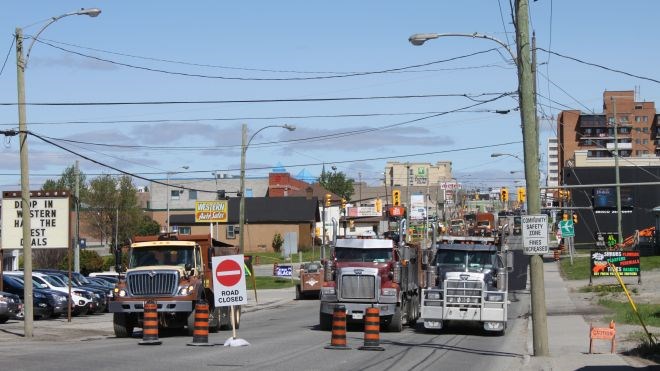In March, the City of Timmins learned it would receive $3 million in provincial road construction funds under the Connecting Links program. But despite getting the highest available amount, it’s still just a drop in the bucket for what’s needed to fully repair the road.
Alternatively known as Algonquin Boulevard or Riverside Drive at different points along the route, Highway 101 runs for 21.2 kilometres through the city as a main thoroughfare, doubling as the provincial highway. It’s a notoriously rough stretch of highway, pockmarked with cracks and potholes and perpetually under construction.
Although the city has been making some headway on repairs over the last several years, Timmins Mayor Steve Black said the incremental portions of funding allotted to the city year to year aren’t nearly enough to get the job done.
A 2016 AECOM report commissioned by the city estimated the full scope of work would cost $95.5 million over 10 years, but by 2017 that number had increased to $120 million.
Part of the problem, Black said, is the road’s length and breadth.
“In most communities, the Connecting Links are a couple of kilometres of highway, so the program works very well. You can apply to get your highway redone and not have to worry about it for 30 years,” Black said.
“In our case, we have a 21-kilometre, four-lane stretch of highway to do in the Connecting Links program and, unfortunately, the $3-million maximum is quite restrictive in getting some of the larger phases done, some of the bigger sections done, or really getting a substantial amount of work done in one year.”
It would be more cost-effective for the city to be able to tender out the entire project, or large sections of it, all at once, he suggested. But to make it more affordable, the city has broken the project up into smaller segments. That means the work is already behind schedule.
City representatives have been diligently lobbying the province to double the maximum eligible amount, to $6 million, but that has yet to change.
Funding under the Connecting Links program is earmarked to help municipalities cover the cost of maintenance of provincial highways running through their communities. According to the province, there are about 350 kilometres of roads and 70 bridges along connecting links in 77 municipalities across Ontario.
After the outcry that ensued when the program was discontinued in 2013, the province reinstated the initiative two years later, assigning it an annual budget of $15 million, which is increasing incrementally – to $20 million for 2016-2017, to $25 million in 2017-2018, and to $30 million by 2018-2019.
In 2016, Timmins was successful in getting the full amount for which it was eligible, $3 million, but it was shut out of funding last year.
Instead, council voted to internally finance the portion of work slated for 2017.
“In our mind, it was too critical that it couldn’t wait,” Black said. “So, while it was disappointing that we didn’t get the provincial funding, council made a decision that we needed to go ahead anyway.”
This year, the city was again successful getting another $3 million, and so work will kick off from a previously repaired portion and focus on a section that’s “deteriorated significantly,” Black said.
“The sections that have been repaired in the last couple of years, our residents are quite happy and obviously we'd like to see more of it done in the community, so we'll continue to work at it with the funding that is made available and continue to see improvements as we go.”
Black is hopeful that the municipality will be able to tap into infrastructure funding announced in the 2018 Ontario Budget to complement the Connecting Links funding to help complete the upgrades in future years.
But in the meantime, the city will chip away at the growing amount of work needed, one pothole-riddled section at a time.
“I think the work will get done,” Black said. “It’s a question of how long it’s going to take to get the work in.”




